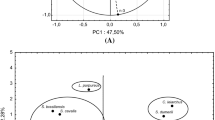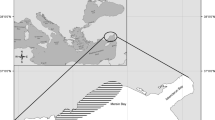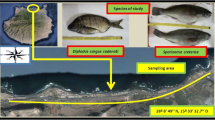Abstract
Ecological investigations were carried out on Indian marine puffers, Chelonodon patoca, Sphaeroides oblongus, Lagocephalus lunaris and Lagocephalus inermis, the four major species available in the coastal waters of the Bay of Bengal, India. The seasonal intraspecific and interspecific abundance and average daily landings were noted. The high hepatosomatic index and low lipid ratio of muscle to liver indicated accumulation of lipid in the liver. The lipid content was at its maximum during the monsoon (July–October) in all the species as was observed from the study of the seasonal variation of liver lipids. The puffers are mainly bottom feeders and the molluscs Umbonium vesterium and Donax incarnatus are the major prey group, constituting 56.0–87.5% of their food content. The liver and ovary had the maximum toxicity in monsoon during their spawning season. The liver oils so far tested from these fishes had no toxicity and the study reveals that the ecologic information will be helpful in monitoring the quality for the safe isolation of polyunsaturated fatty acid —entiched oil from these non-conventional sources.
Similar content being viewed by others
References
Noguchi T, Ebesu JSM. Puffer poisoning: epidemiology and treatment. J. Toxicol.-Toxin Rev. 2001; 20: 1–10.
Russell FE. Venomous and poisonous marine animals: the clinical problem. In: Thomson MF, Sarojoni R, Nagabhusanam R (eds). Bioactive Compounds from Marine Organisms. Oxford-IBH Publishing Co. Pvt. Ltd., New Delhi. 1991; 151–159.
Vietmeyer ND. The preposterous puffer. National Geography 1984; August: 261–270.
Nunez-Vazquez EJ, Yotsu-Yamashita M, Sierra-Beltran AP, Yasumoto T, Ochoa JL. Toxicities and distribution of tetrodotoxin in the tissue of puffer fish found in the coast of Baja California Peninsula, Mexico. Toxicon 2000; 38: 729–734.
Loke YK, Tam MH. A unique case of tetrodotoxin poisoning. Med. J. Malaysia 1997; 52: 172–174.
Mahmud Y, Arakawa O, Noguchi T. An epidemic survey on fresh water puffer poisoning in Bangladesh. J. Nat. Toxins. 2000; 9: 319–326.
Ghosh S, Hazra AK, Mitra SK, Mukherjee B. Poisonous fishes: potential begetter of bioactive substances. In: Devadasan K, Mukundan MK, Antony PD, Viswanathan Nair PG, Perigreen PA, Joseph J (eds). Nutrients and Biocative Substances in Aquatic Organism. Society of Fisheries Technologists (India), Cochin. 1993; 44–58.
Miyazawa K, Noguchi T. Distribution and origin of tetrodotoxin. J. Toxicol.-Toxin Rev. 2001; 20: 11–33.
Mitra SK, Sanyal B, Ganguly SN, Mukherjee B. A hypnotic barbitone from Sphaeroides oblongus (Bloch). J. Chem. Soc. Chem. Commun. 1989; 1: 16.
Hazra AK, Ghosh S, Banerjee S, Mukherjee B. Studies on lipid and fatty acid composition of puffer livers from Indian coastal waters with seasonal variation. J. Am. Oil. Chem. Soc. 1998; 75: 1673–1678.
Stansby M. A clinical study on the role of fish oil in alleviating human heart diseases. In: Baslow SM, Stansby M (eds). Nutritional Evaluation of Long Chain Fatty Acids in Fish Oil. Academic Press, London. 1982; 263–266.
Hazra AK, Mukherjee B, Ghosh S. A novel processes for extraction of non-toxic oil having high eicosapentaenoic acid and docosahexaenoic acid content from liver of marine non-edible fishes. Indian Patent No. AA 2468. The Gazette of India. New Delhi, Saturday, August 30, 1997; No. 35, Part III, Sec. 2: 1183.
Strikland JDN, Parsons TR. A practical handbook of Sea water analysis. Bull. Fish. Res. Board. Can. 1968; 167: 49–80.
Bigg MA, Perez MA. Modified volume frequency-volume method to assess marine mammals food habits. In: Beddington JR, Beverton RJH, Lavigne DM (eds). Marine Mammals and Fisheries. George Allen, Union, London. 1985; 277–283.
Bligh EG, Dyer WJ. A rapid method of total lipid extraction and purification. Can. J. Biochem. Physiol. 1959; 37: 911–917.
Kawabata I. Food hygiene examination manual. Japan Food Hygiene Association Environmental Health Welfare, Tokyo. 1978.
Ghosh S. Indian marine poisonous fishes, chemical and pharmacological investigation in search of bioactive compounds (PhD Thesis). University of Calcutta, Calcutta, India. 1999.
Ando S, Mori Y, Nakamura K, Sugawara A. Characteristics of lipid accumulation types in five species of fishes. Nippon Suisan Gakkaishi 1993; 59: 1559–1564.
Lie O, Lied E, Lambersten G. Liver retention of fat and fatty acids in Cod (Gadus morhua) fed different oils. Aquaculture 1986; 59: 187–196.
Hayashi K. Liquid was esters in liver oils of deep sea teleosts Laemonema longipes. Nippon Suisan Gakkaishi 1987; 53: 2263–2267.
Wu CS, Tsay YJ, Liou HJ. Studies on the content and hydrogenation condition of squalene from liver oil of deep sea shark. J. Fish. Soc. Taiwan 1980; 7: 43–55.
Wu RSS. The feeding habits of seven demarsal fish species in a subtropical estuary. Asian Mar. Biol. 1984; 1: 17–26.
Yasumoto T, Murata M. Marine toxins. Chem. Rev. 1993; 93: 1897–1909.
Yang CC, Han KC, Lin TJ, Tsai WJ, Deng JF. An outbreak of tetrodotoxin poisoning following gastropod mollusc consumption. Hum. Exp. Toxicol. 1995; 14: 446–450.
Burr ML. Fish and cardiovascular system. Prog. Food. Nutri. Sci. 1989; 13: 291–316.
Endo R. Toxicological studies on puffer fishes: comparison of toxicities in the various species. J. Toxicol. Sci. 1984; (Suppl. 1): 1–11.
Sherindan MA, Allen WV, Kerstetter TH. Seasonal variation in the lipid composition of steelhead trout, Salmo gairdneri Richardson, associated with parr-smolt transformation. J. Fish Biol. 1983; 23: 125–134.
Author information
Authors and Affiliations
Corresponding author
Rights and permissions
About this article
Cite this article
Ghosh, S., Hazra, A.K., Banerjee, S. et al. Ecological monitoring for ascertaining the bio-safety of liver lipids from some Indian marine puffer fishes. Fish Sci 71, 29–37 (2005). https://doi.org/10.1111/j.1444-2906.2005.00927.x
Received:
Accepted:
Issue Date:
DOI: https://doi.org/10.1111/j.1444-2906.2005.00927.x




